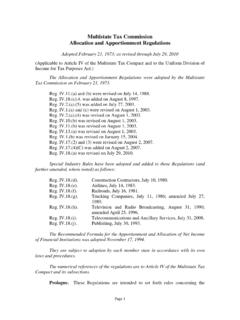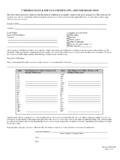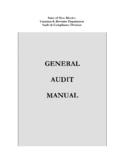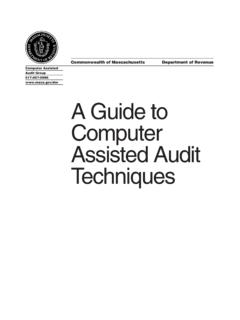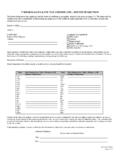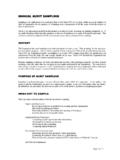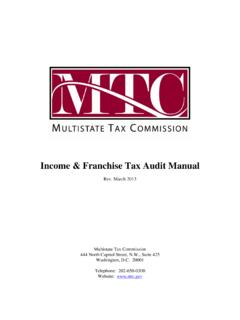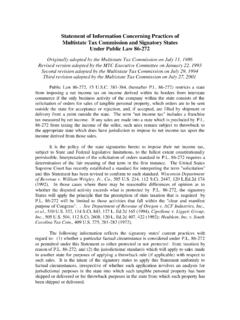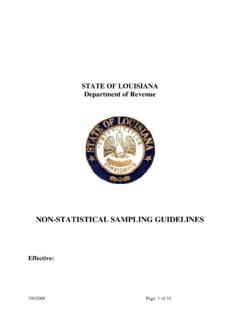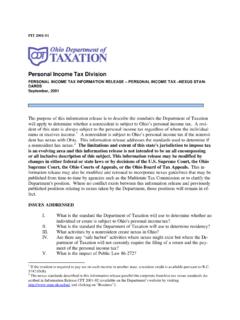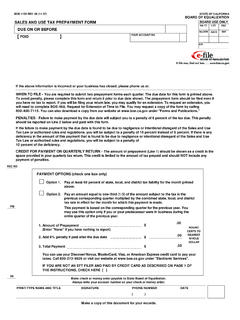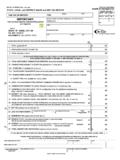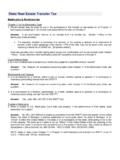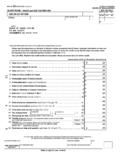Transcription of Audit Manual Chapter 13 - mtc.gov
1 Audit Manual Chapter 13 Statistical Sampling Sales and Use Tax Department california State board of equalization This is an advisory publication providing direction to staff administering the Sales and Use Tax Law and Regulations. Although this material is revised periodically, the most current material may be contained in other resources including Operations Memoranda and Policy Memoranda. Please contact any board office if there are concerns regarding any section of this publication. STATISTICAL SAMPLING November 2001 Table of Contents Statistical Sampling INTRODUCTION .. General .. Testing with Statistical Samples.
2 Advantages of the Statistical Sample .. Sampling Plans .. SETTING UP THE TEST .. General .. Define the Objective of the Test .. Define and Limit the Population .. Define the Characteristic Being Measured .. Special Considerations .. DETERMINING SAMPLE SIZE .. General .. Sample Size Formula .. Pilot Samples .. Sample Size Tables .. Factors Affecting Sample Size .. SAMPLE SELECTION TECHNIQUES .. General .. Unrestricted Random Sampling .. Stratified Random Sampling .. Systematic Sampling .. Cluster Sampling .. Combination .. Methods of Selecting a Sample .. Computer Audit Specialist.
3 EVALUATION OF SAMPLE RESULTS .. General .. Statistical Sampling Symbols, Formulas and Definitions .. Analysis of Data .. Expanding a Sample .. ESTIMATION PROJECTION TECHNIQUES .. General .. Mean-Per-Unit Estimation .. Difference Estimation .. Ratio Estimation (Percentage of Error) .. WORKING PAPER TECHNIQUES .. General .. Minimum Documentation .. STATISTICAL SAMPLING STANDARDS .. Minimum Errors and Evaluation Standards .. GLOSSARY OF STATISTICAL TERMS .. Audit Manual January 2000 STATISTICAL SAMPLING INTRODUCTION GENERAL This Chapter provides guidelines to follow when a statistical sample is used to perform a test in an Audit .
4 There is no intention to establish rigid rules; rather this Chapter will set forth general goals for statistical sampling and will allow the auditor discretion in the implementation of various analytical procedures to develop an appropriate sampling plan. Planning and evaluating Audit samples is a critical part of the board s mission, as stated in section of this Manual . During the sample planning phase, the auditor gathers information about the taxpayer s accounting systems and tax issues. The auditor should take the opportunity to educate the taxpayer on the objectives of the sampling process and encourage the taxpayer to offer suggestions on designing the sampling plan.
5 The taxpayer may be able to share specialized knowledge of the accounting system and sampling techniques that could result in a more effective and efficient Audit . The auditor should work with the taxpayer to find the best procedures for the given situation. However, it is a general principle of auditing that the auditor is ultimately responsible for assuring that adequate tests are conducted to provide the auditor with assurance of the accuracy of the records. The auditor should refer to Chapter 4 for general Audit procedures regarding tests of specific items. The primary objective of a sales and use tax Audit is to determine, with the least possible expenditure of time for both the taxpayer and staff, the accuracy of reported tax.
6 To accomplish this, the auditor should take into account the possibility of both overpayments and underpayments in analyzing the sampling plans necessary to accurately measure variances from the proper amount of tax due. All such variances should be taken into account by the auditor when assessing the net overpayment or underpayment resulting from the Audit . A sample or an Audit may result in a net refund if the dollar value of tax overpayment errors exceeds the value of tax underpayment errors. As stated in section of this Manual , the board is just as willing to recommend a refund of an overpayment as we are to propose a deficiency determination.
7 The information and guidelines presented are designed for use by tax auditors and should be used in conjunction with material received in the statistical sampling class. Auditors receive a brief introduction to statistical sampling in their initial Audit training class, and with the help of their supervisor or a more experienced auditor, they should use the information in this Chapter to conduct audits incorporating statistical sampling techniques. Section contains a glossary of terms peculiar to testing by the statistical sampling method. board of equalization tax auditors are required to have a working knowledge of these terms.
8 It is suggested the auditor be familiar with these terms prior to reading this Chapter . STATISTICAL SAMPLING January 2000 TESTING WITH STATISTICAL SAMPLES Publications of the AICPA (American Institute of Certified Public Accountants) and its committees have increasingly recognized the importance of statistical sampling in modern accounting and auditing. Statistical sampling is now used widely in private industry and by certified public accounting firms. The board encourages testing with the use of statistical sampling techniques whenever feasible. The board s auditors must develop and use recognized testing methods that will be accepted with confidence by taxpayers and their accountants.
9 ADVANTAGES OF THE STATISTICAL SAMPLE A statistical sample has two important characteristics the estimation of the required sample size and the objective projection and evaluation of the sample results. When a sample is obtained by this method, it is possible to state with a desired level of confidence that the sample result is no further away than some calculable amount from the result attainable from a complete examination of all items. This provides a number of advantages which are explained as follows: a. Sample Result Is Objective and Defensible One important feature of statistical sampling is that, in an unstratified random sampling plan, all items in the population have an equal chance for selection as a sample item.
10 This random selection process eliminates bias and would reduce any possible argument that the sample is not representative. The sample is not only objective but defensible before the taxpayer, a court of law, one s supervisors, or even more important, before one s own conscience. b. Method Provides for Advance Estimation of Sample Size An advance estimation of the necessary sample size can be computed based upon statistical principles. The advance estimation provides both a defense for the reasonableness of the sample size and a justification for the expenditure involved. However, determination of sample size is not purely mechanical, but calls for good analytical skills and decisions by the auditor.
